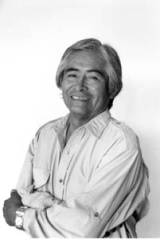|
|
LITR 4332: American Minority
Literature
Simon J. Ortiz “Travels in the South” pages:
278 - 281 Reader:
Catherine J Johnson Respondent:
Nancy
Broadway
Biographical Information: Simon
J. Ortiz was born May 27, 1941 in Albuquerque, New Mexico in the Acoma Pueblo
community there. It was a hard life for him and his eight brothers and sisters;
they went to a school where they were punished for speaking their native tongue.
His childhood therefore was spent learning English as a second language,
yet he triumphed and went on to work through the hardships of the two cultures
colliding. He later went on to attend Fort Lewis College and the University of
New Mexico for undergraduate studies and received his M.F.A. as an International
Writing Fellow at the University of Iowa’s Writer’s School. Since then he
has taught writing and Native American Literature at various institutions, and
is currently teaching at the University of Toronto. Simon
is a contemporary Native American writer and as said by 2001 student Dennis
Clifford is said to be “the Native American Writer” for he has been the most
recognized poet. He continues to be a very prominent part of the literature
world and has many accomplishments such as poems, short stories, essays and
children’s books. Objectives: 3b.
Loss
and Survival – The Native Americans lost their lands and many lost their
lives and now they survive in their current situations. 4.Assimilation
or Resistance –
They face the choice to become a part of the Anglo industrial culture but choose
to remember their history and keep their culture alive. 5a.
To discover the power of poetry and
fiction to help “others” hear the minority voice and vicariously share the
minority experience. Literary
Term:
Imagery – a term used to
refer to (1) the actual language that a writer uses to convey a visual picture
and (2) the use of figures of speech, often to express abstract ideas in a vivid
and innovative way. Ex:
As Todd Wielichowski noted in his interpretation, Ortiz uses imagery of the
squirrel and the red bird refusing the stale white bread. The bird and squirrel
are named brothers and they refuse the stale white bread as the Native American
people refuse what the white culture wants them to accept. Interpretation:
This
poem talks about the scattering of the many tribes in America in two ways. The
first is the travels of the author through the south, which resembles the path
many Native Americans took when being moved to reservations like the Cherokee
Trail of Tears. The second is the many people and places he goes along the way,
not being able to find the Indians in Dallas and the ones he finds are without
hope and “crying for their lost life.”
He also conveys the issue of being different and being treated
differently because of the way he looks. He talks of “having a hard time in
Atlanta” because he didn’t wear the same clothes or hairstyle, and the
nervous stares he received.
This poem is a journey of self-discovery, the author starts out within a
culture, leaves that area in search for more and discovers how many different
Indian tribes and people were forgotten. While he travels, he notices the loss
of culture in many others and starts to lose some himself, he is then reminded
not to lose what he has but to “keep together” and that it is not mandatory
to accept what is offered. Questions: What do you think the role of Chief Alvin McGee was? What
is the significance of him not supporting Wallace in politics? Is
the message of retaining ones culture and remembering the past carried
throughout the poem? What
are some other interpretations of parts of this poem?
|

